Awesome Binocular Astronomy with the Help of Mobile Apps
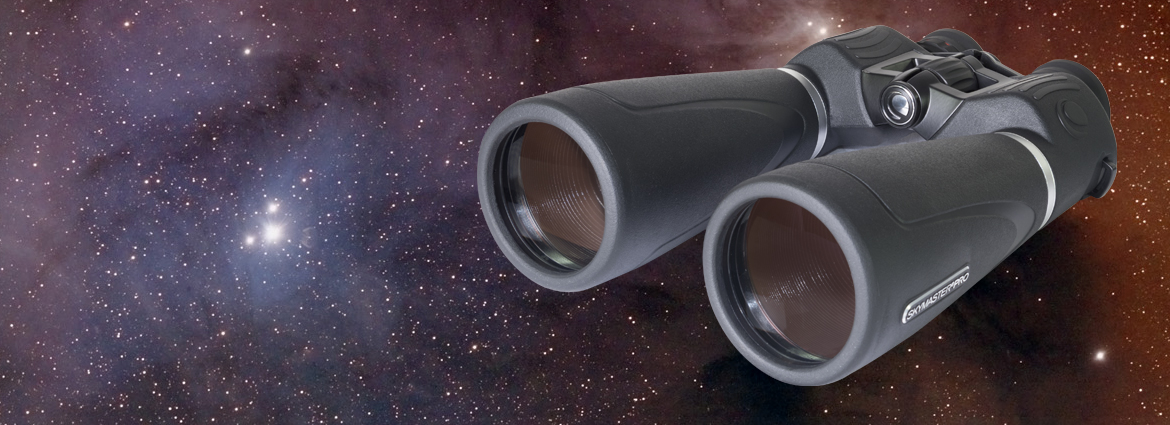
Not everyone owns a telescope, but there are plenty of astronomical sights to see using a regular pair of binoculars — and mobile astronomy apps can tell you what's up in the evening (or morning) sky and where to look. In this edition of Mobile Stargazing, we'll help you choose binoculars for astronomy and tell you about a range of fascinating objects in the fall sky, from the nearby moon to a galaxy far, far away.
Binocular basics
When you break it down, binoculars are simply a matched pair of small telescopes mounted precisely and rigidly together to deliver a stereo image into your two eyes. The lenses at the front are called objectives. As with any optical device, the larger the area of those lenses, the more light they collect and concentrate into your pupils. In binocular specification numbers, such as 7 x 50, the second number is the diameter of the objective lenses in millimeters. The small lenses you look into are called eyepieces or oculars, and they do the job of magnifying the twin images you see. In the case above, the 7x means the binoculars magnify by seven times.
Regular telescopes invert and/or create a mirror image of the view, but a set of prisms inside the binoculars act to correct for that. (Similar prisms are used in portable telescopes called spotting scopes, intended for use in viewing Earthbound targets, and in birdwatching telescopes.) Large binoculars are spaced wider than human eye separations, so the prisms in those binoculars also redirect the light path to decrease the separation. Additionally, the wider lens spacing in larger binocular pairs enhances the depth of field. [How to Choose Binoculars for Astronomy and Skywatching]
Binoculars are terrific for astronomy because they have an inherently wide field of view, making it far easier to hunt for objects in the sky. These instruments are also easy to carry around. Their limited magnification, usually under 10 times, is more than enough for many classes of objects. And their light-gathering ability makes dim objects shine. Viewing with two eyes is easier than single-eyed telescope viewing, too. In fact, many beginner astronomers spend months or years learning the sky with binoculars before graduating to telescopes.
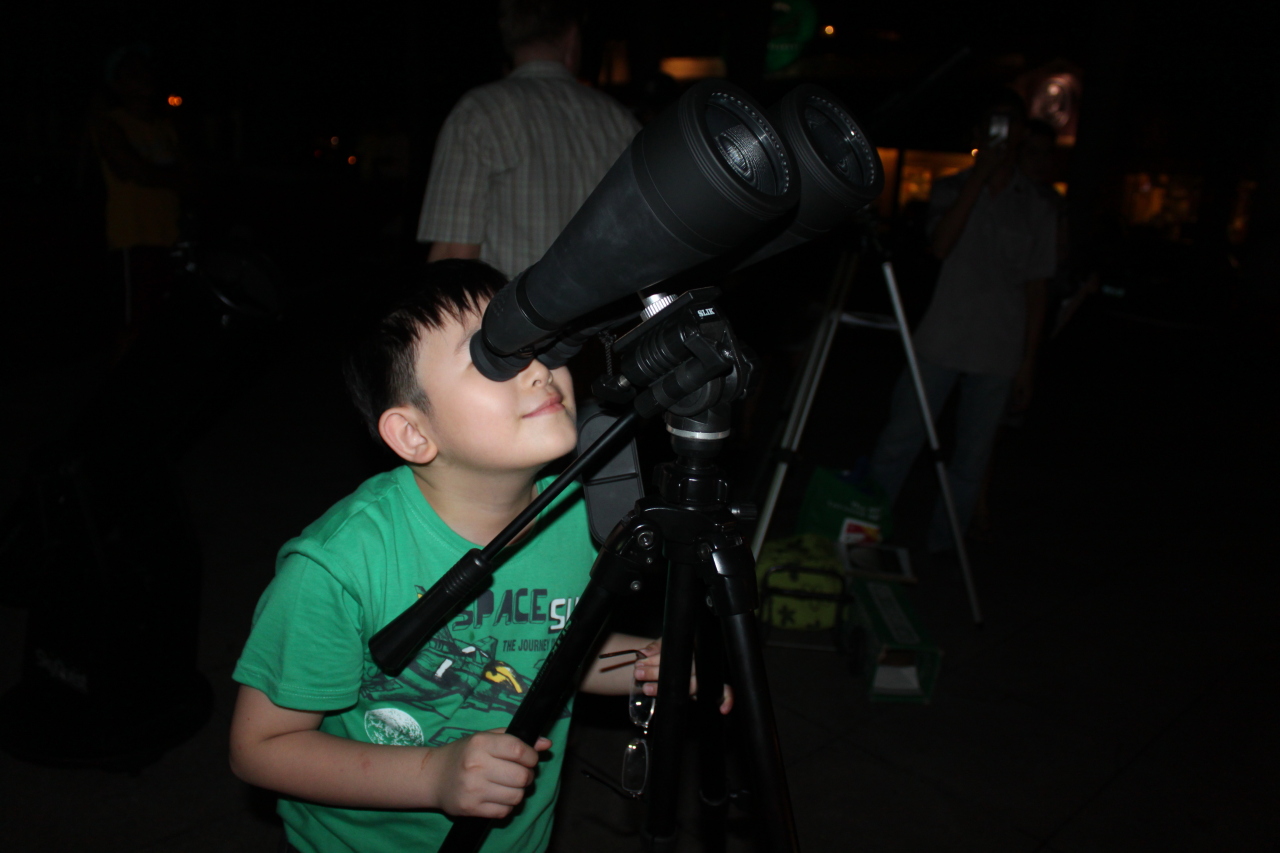
The binoculars' field of view is usually expressed by saying how many horizontal feet of landscape at 1,000 yards away will be in view (or how many meters at 1,000 meters). These values are often labeled along with the magnification and aperture size. In astronomy, we express the size, or angular diameter, of objects in degrees, minutes and seconds of arc. There's 1 degree of view for every 52.5 feet at 1,000 yards (1 degree for every 17.5 meters at 1,000 meters). So binoculars that are rated as 420 feet at 1,000 yards show you 8 degrees of sky. The bowl of the Big Dipper is about 10 degrees wide, while the moon is only one-half of a degree, or 30 arc-minutes, across.
Most binoculars work perfectly well for astronomy. But if you are buying specifically with astronomy in mind, choose a pair that comes with large objectives, but which is still comfortable for you, and the kids, to hold. You can buy a bracket for mounting the binoculars on a tripod, as well. (Check for a mounting-screw receptacle. It might be hidden under a cover.)
Coated optics are essential, so you can maintain contrast and avoid unwanted colors appearing on the edges of bright objects. Better binoculars will allow one ocular to be focused independently, in case the prescriptions in your eyes are different, and you can use some binoculars while wearing glasses. A good pair of binoculars will last a lifetime. The name brands have a range of quality levels. The telescope manufacturer Celestron sells binoculars, too, including the large SkyMaster series. Due to manufacturing variations, it's always a good idea to try binoculars in the store before buying, so you can be sure they achieve focus and deliver a crisp, blended image.
Get the Space.com Newsletter
Breaking space news, the latest updates on rocket launches, skywatching events and more!
Exploring the moon
Generally speaking, planets are not very impressive in binoculars, because these objects are too small in angular diameter for details to be visible. If your binoculars are strong enough, you should be able to see Jupiter's four Galilean moons as tiny pinpoints in a line flanking the planet. The moons change position nightly as they orbit Jupiter. You can use your astronomy app to zoom in and see the current arrangement. Likewise, Saturn should appear slightly oblong due to its rings.
Binoculars aren't useful for meteor showers, either. For those, you'll want to be able to watch large swaths of the sky.
The moon, however, is always an attractive sight in binoculars. You'll have no difficulty seeing the starkly shadowed terrain; the large, dark gray plains of cooled magma called maria, or "seas," where most of the Apollo missions landed; and the medium and large craters. Your astronomy app should offer the option to display the labels for major lunar features. In SkySafari 5, tap With Surface Labels under the Solar System settings. You will also be able to see the long streaks of ejecta splayed out from recent craters such as Tycho (near the southern pole) and Copernicus. Additionally, you can search for features by name, and center the view on them.
Every few months, for a few hours near the first-quarter moon, a feature called the Lunar X becomes visible on the moon. When the rims of the craters Parbach, la Caille and Blanchinus are illuminated from a particular angle of sunlight, they combine to form a small, but very clear and bright "X" shape. It's located on the line that divides the sunlit side of the moon from the side in shadow, called the terminator, about one-third of the way up from the southern pole (bottom) of the moon. The prominent, round crater Werner sits to the lower right. The next Lunar X will form in twilight during the late afternoon of Sunday, Nov. 6, peak in darkness around 7:44 p.m. EDT (2344 GMT)and last until approximately 10 p.m. EDT (0200 GMT on Nov. 7). It will be visible wherever the moon is in darkness during those hours, including the central and eastern US and Europe — use your mobile astronomy app to see where the moon will be for your location. [2016 Full Moon Calendar]
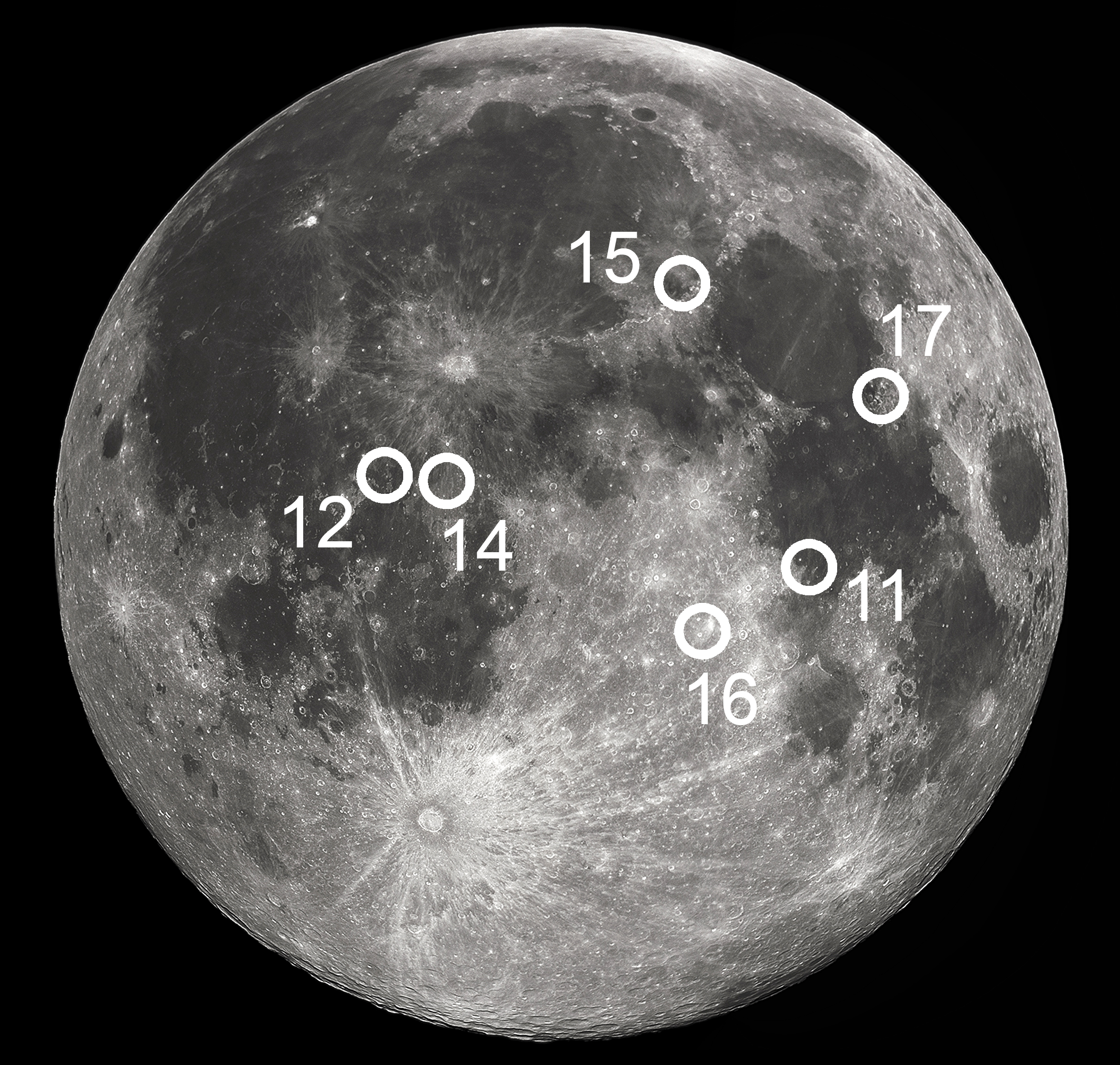
More distant binocular targets
The best targets for binoculars include small asterisms (star patterns), widely separated double stars, open star clusters, globular clusters and large galaxies. Below is a sampling of targets visible annually in autumn evenings; you can use the search function on your astronomy app to find the area of sky where these targets are located. To gain a sense of scale, the SkySafari 5 app allows you to display a field of view (FOV) circle that matches that of your binoculars. Under the settings menu, tap Display and then toggle on one of the "Custom field of view" options listed. By tapping the right arrow for that list, you can manually enter your own FOV, or choose standard, 10 x 50 binoculars.
Double stars are popular with amateur astronomers. Many of the stars that were named before the invention of the telescope have turned out to be pairs or multiples of closely spaced stars. Some of them can be separated visually, or split, using binoculars. Epsilon Lyrae sits only 1.5 degrees from the bright star Vega in Lyra, and is popularly known as the Double Double. To the naked eye, it looks like one star. In binoculars it splits into twin, closely spaced stars, and a good telescope splits each of those into another tight pair! In the northern sky, at the bend in the handle of the Big Dipper, is the bright star Mizar, with its dim, naked-eye companion Alcor just above it. In strong binoculars, Mizar splits into a pair of stars.
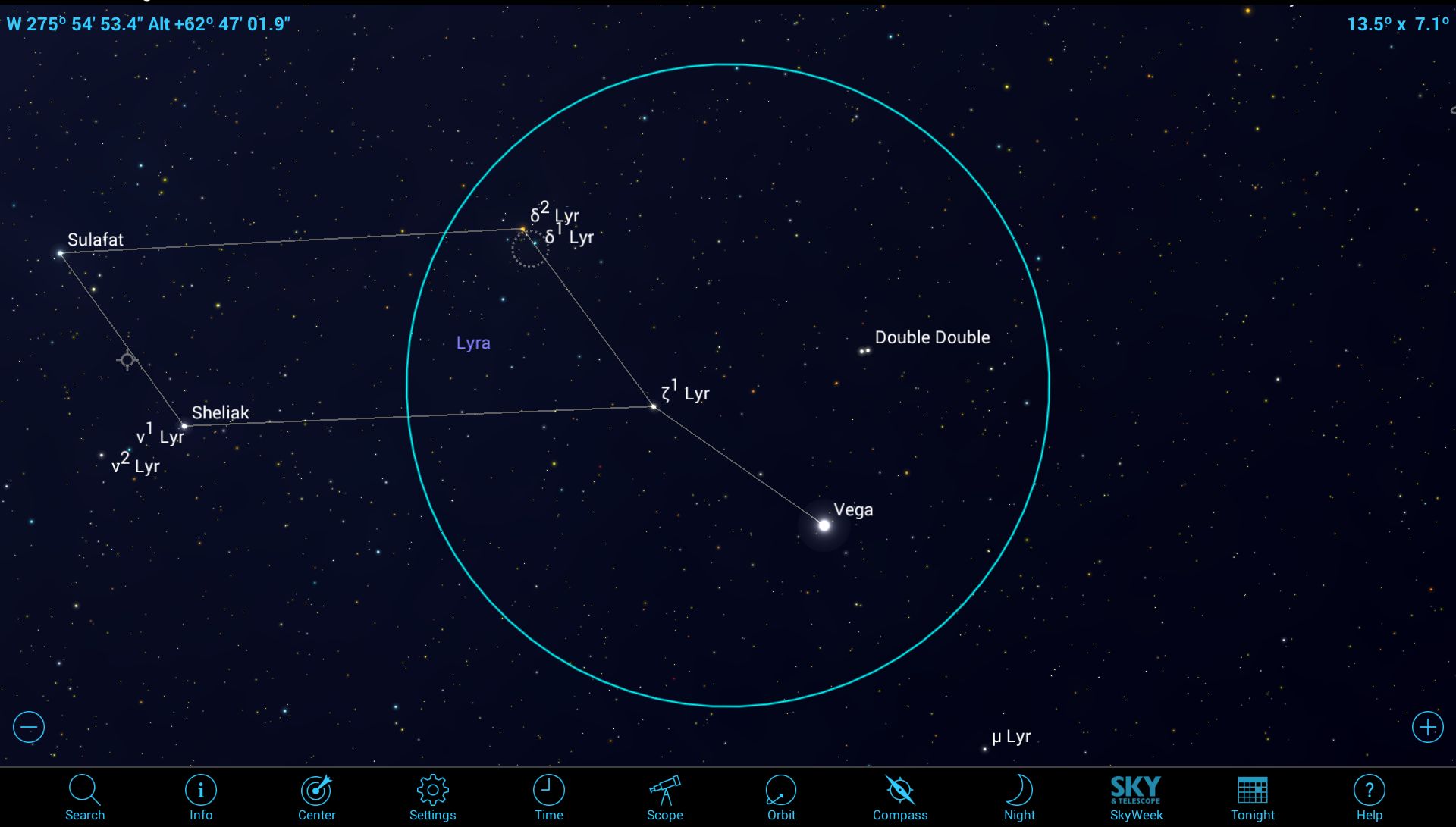
Asterisms are pictures made up of groups of stars that may include parts of a larger constellation. Examples include the Big Dipper (in the constellation Ursa Major) and the Northern Cross (in Cygnus). Some are small patterns best seen in binoculars or telescopes. One of the best of these is the Coat Hanger, an asterism 1.5 degrees across, or three times the diameter of the full moon, and shaped like an old-fashioned straight hanger with a curled hook. It sits in the Milky Way, about midway between the bright stars Altair and Vega. Watch out, though — it's upside-down for Northern Hemisphere observers!
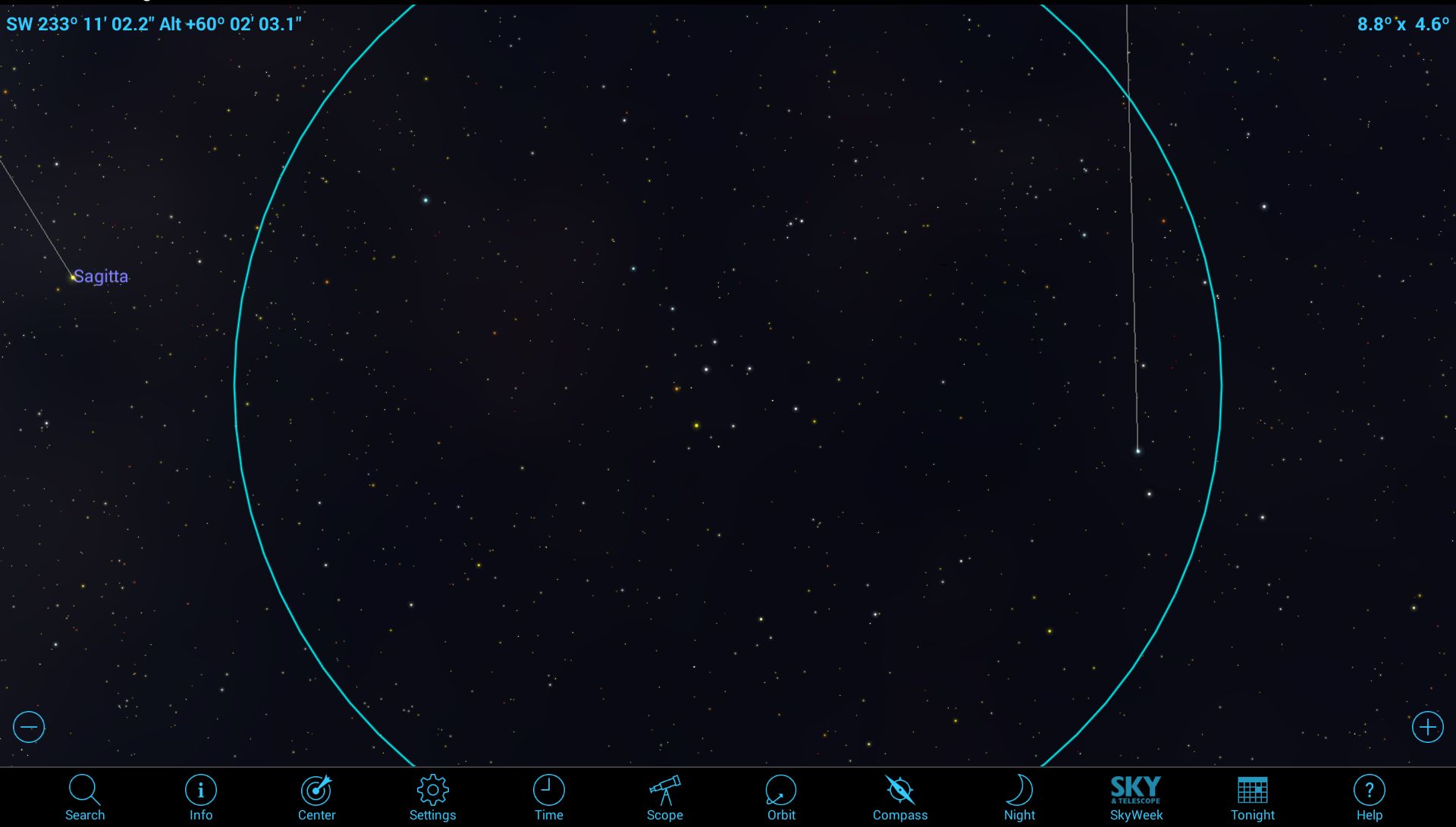
Also popular with astronomers are the 110 objects in the Messier List, many of which are excellent binocular targets. Starting in 1751, the French comet hunter Charles Messier catalogued a series of faint fuzzy objects that resembled comets. These objects included star clusters, nebulas and galaxies. Astronomy apps list the objects by Messier number: M1, M2 and so on. SkySafari allows you to sort the list by how bright they appear (visual magnitude) and to highlight all of them in the display. Tap the Search icon, scroll to Messier Objects and tap the Sort By label. Tapping Highlight Objects will draw a small blue circle where the objects are located.
Many of the Messiers are large, extended objects that are easier to see in the brighter view and magnification of binoculars. The Wild Duck Cluster, or M11, sits in the southern sky, in the Milky Way below the bright star Altair. Look for a dim but dense clump of stars about 14 arc-minutes across (half a moon in diameter). It contains several thousand stars. While you are there, scan the rich star fields of the Milky Way northward from the area near Sagittarius. There are more knots of stars, nebulas and dark dust lanes to be discovered in your binoculars, especially if you can find a site away from city lights.
The Andromeda Galaxy, or M31, sits in the evening eastern sky to the left of the great square of Pegasus. It's a large spiral galaxy 2.5 million light-years distant that is easily seen in binoculars. Depending on your sky conditions, and the size of your binoculars, you may see only the bright galactic core, or also the extended disk that stretches to six full-moon diameters across! A few more Messiers to try for are Messier 22 and 24 in Sagittarius, the Great Globular Cluster in Hercules (M13), and the Pleiades in Taurus (M45). [Andromeda Galaxy Photos: Amazing Pictures of M31]
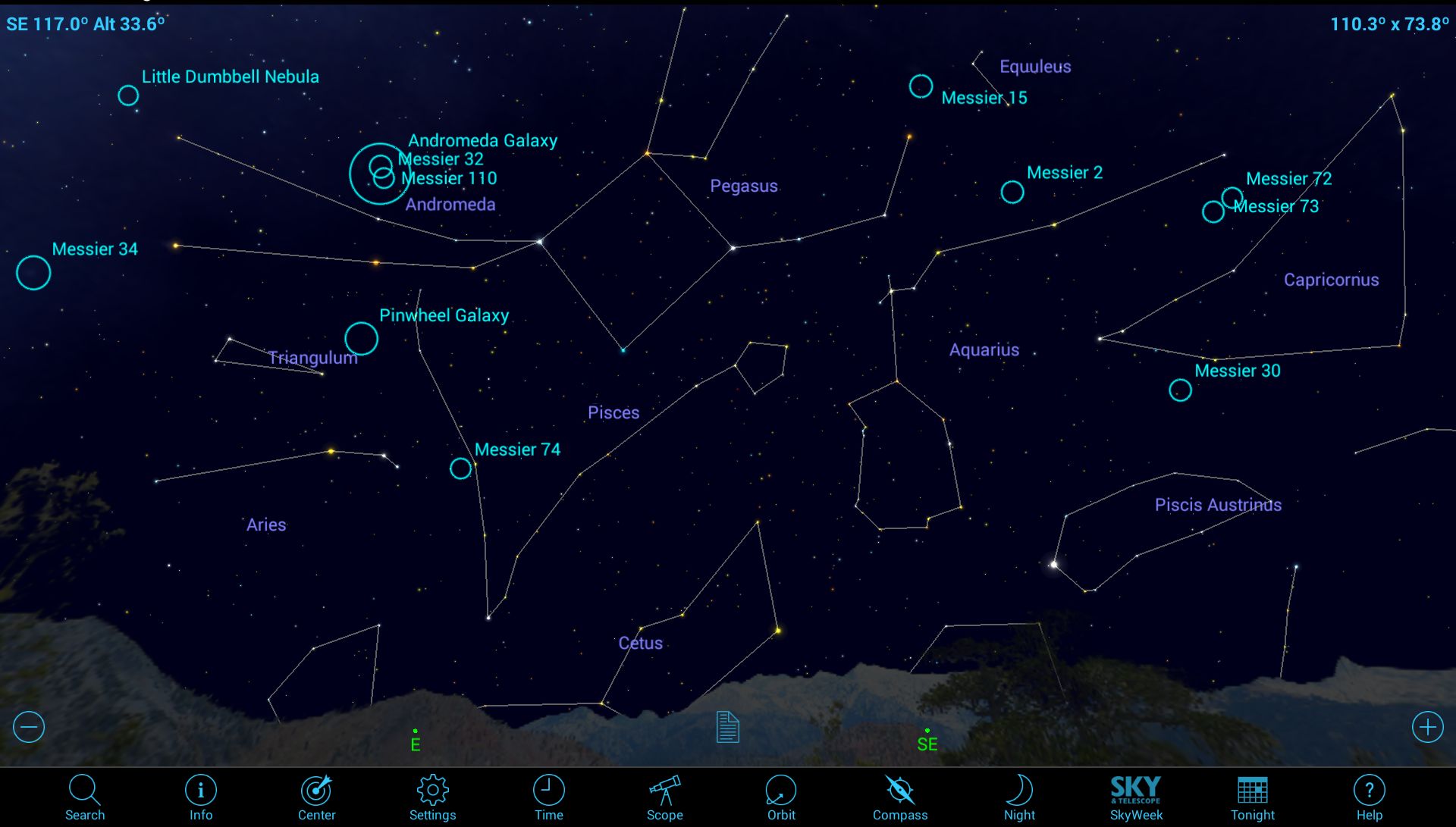
Binoculars are also terrific for viewing comets, whose tails can span many degrees of sky. As of this writing, there are no binocular comets observable, but a good one could be discovered any time — so stay tuned!
Going beyond
The Astronomical League website has plenty of information about astronomy using binoculars. It also includes links to binocular objects and spreadsheet lists for double stars, asterisms, star clusters and Messier objects. In a future edition of mobile stargazing, we'll review more objects you can find using binoculars.In the meantime, keep looking up!
Editor's note: Chris Vaughan is an astronomy public outreach and education specialist, and operator of the historic 1.88-meter David Dunlap Observatory telescope. You can reach him via email, and follow him on Twitter @astrogeoguy, as well as on Facebook and Tumblr.
This article was provided by Simulation Curriculum, the leader in space science curriculum solutions and the makers of the SkySafari app for Android and iOS. Follow SkySafari on Twitter @SkySafariAstro. Follow us @Spacedotcom, Facebook and Google+. Original article on Space.com.
Join our Space Forums to keep talking space on the latest missions, night sky and more! And if you have a news tip, correction or comment, let us know at: community@space.com.
Chris Vaughan, aka @astrogeoguy, is an award-winning astronomer and Earth scientist with Astrogeo.ca, based near Toronto, Canada. He is a member of the Royal Astronomical Society of Canada and hosts their Insider's Guide to the Galaxy webcasts on YouTube. An avid visual astronomer, Chris operates the historic 74˝ telescope at the David Dunlap Observatory. He frequently organizes local star parties and solar astronomy sessions, and regularly delivers presentations about astronomy and Earth and planetary science, to students and the public in his Digital Starlab portable planetarium. His weekly Astronomy Skylights blog at www.AstroGeo.ca is enjoyed by readers worldwide. He is a regular contributor to SkyNews magazine, writes the monthly Night Sky Calendar for Space.com in cooperation with Simulation Curriculum, the creators of Starry Night and SkySafari, and content for several popular astronomy apps. His book "110 Things to See with a Telescope", was released in 2021.











